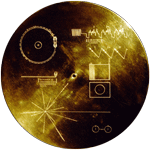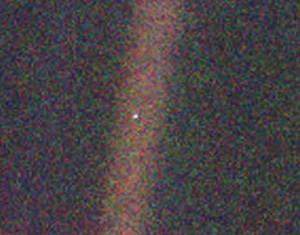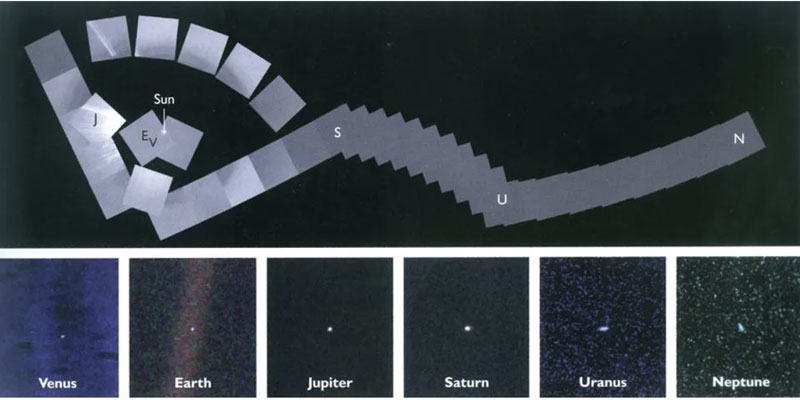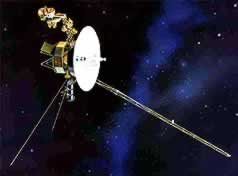 |
    |
Cat: SCI |
|
Pale Blue Dot |
||
Carl Sagan |
97131u/18220r |
Title
Pale Blue Dot
ペール・ブルー・ドット
Sub
Title
A vision of the human future in space
宇宙における人類の未来ビジョン
Author
Carl Sagan
カール・セーガン
Published
1994
1994年
Index
Tag
; 141AU from Sun; Every human ever lived; First snapshot; Golden record; ; Interstellar mission; Launched in 1977; Proof of civilization; Pu-238; ; ;
Why
?
1.
travelers of eternity:
- Many spacecrafts have the names related travel, like "Sputnik (=Companion)", "Explorer", "Orbiter",
"Mariner", "Viking", "Pioneer", "Pathfinder" and "Voyager."
- Matsuo-Basho, 17th century Japanese poet, wrote: "The months
and days are the travelers of eternity. The years that come and go
are also voyagers......"
- Cf: "Where are the Voyagers?"; JPL HP
1. 月日は百代の過客:
- 多くの探査機は、"旅"に関連した名前を持っている。スプートニク、エクスプローラー、オービター、マリナー、バイキング、パイオニア、そしてボイジャーである。
- 松尾芭蕉は、奥の細道の冒頭に "月日は百代の過客にして、行かふ年も又旅人也"と書いている。
Summary
要約
>Top 1. Proof of our civilization:
- In 17th century the travel from Holland to China took a year
or two, now Voyager travels from Earth to Jupiter spending similar
time.
- Among many success of spacecrafts, those of Voyager-1 and Voyager-2
are unforgettable and surprisingly are working now! I
- Even in the future our earth will be swallowed by the Sun swelled
into red giant, they remain as the proof of our civilization.
- Voyagers are destined to wander through eternity far from the
stellar islands. They have embarked on epic voyages.
- Voyagers will never return to Earth. But its scientific discoveries
and travelers' tales do return.
1. 我々の文明の証:
- 17世紀にはオランダから中国までの航海には1-2年を要した。今やボイジャーは地球から木星まで同じような時間で旅行する。
- 多くの探査機の成功の中でも、ボイジャー1号と2号の成功は忘れがたい。しかも今なお動き続けているのだ! 我々の地球がたとえ将来膨張する赤色巨星の太陽に飲み込まれても、彼らは我々の文明の証として残り続ける。
- ボイジャーは星の島々を遠く離れて、永久の放浪を続けることを運命づけられた。彼らは壮大な旅に出発したのだ。
- ボイジャーは再び地球へ戻ってくることはない。しかしその科学的発見や航海者の話は確かに戻ってくるのだ。
>Top 2. What is Voyager spacecraft?:
- ... essence from NASA Homepage
- Voyager launched in 1977, designed to explore four outer planets
of the solar system (Jupiter, Saturn, Uranus, and Neptune). The Voyager
spacecraft used the planets' gravities to swing from one planet to
the next. The Voyager mission has now been extended to explore the
solar system beyond the outer planets.
- Both spacecraft also have adequate electrical power and attitude
control propellant to continue operating until around 2020 when the
available electrical power will no longer support science instrument
operation.
- >Top Both Voyager spacecraft were launched from NASA Kennedy Space Center
at Cape Canaveral, Florida, by a Titan Centaur rocket. The two-stage
rocket boosted the spacecraft into a low orbit around the earth and
catapulted the craft toward Jupiter. Voyager 2 was launched first,
on August 20, 1977. Voyager 1 was launched on a faster, shorter path
on September 5, 1977.
- Voyager 1 encountered Jupiter on March 5, 1979, and Voyager 2
followed on July 9, 1979.
- Voyager 1 flew past Saturn on November 12, 1980, and Voyager 2
flew past on August 25, 1981.
- After its Saturn flyby, Voyager 1 continued northward out of the
ecliptic plane. (520M km/yr = 3.5 AU/yr, 17.3 km/sec)
- Voyager 2 passed Uranus on January 24, 1986, and Neptune on August
25, 1989, and then flew southward into interstellar space. (470M
km/yr = 3.1 AU/yr, 15.8 km/sec)
- The latest trip as of Nov. 24, 2000:
Voyager-1: 79 AU from the Sun (141 AU as of 2018/2)
Voyager-2: 62 AU from the Sun (116 AU as of 2018/2)
- Note: 1AU =150 million km; average distance
between Earth & Sun.
- >Top As the spacecraft used radioisotope (Plutonium-238, half life 88 years) thermoelectric generators,
which produce electricity from the heat resulting from the radioactive
decay of plutonium to power the instruments, computer, radio, and
other systems.
- The spacecraft are controlled and their data returned to the earth
through the Deep Space Network, a global spacecraft-tracking
system.
- The Voyager spacecraft were equipped with instruments to conduct
ten different scientific experiments, including television cameras,
infrared and ultraviolet sensors, magnetometers, plasma detectors,
and cosmic-ray and charged-particle sensors. In addition, the spacecraft
radios were used to gather information about planetary atmospheres
and ring systems.
- >Top Golden record:
A message was placed aboard the Voyager spacecraft to communicate
with any extraterrestrial beings who might come into contact with
the probes. The message was carried on a 30.5-cm (12-in) gold-plated
copper phonograph record containing 115 images and a variety of natural
sounds selected to portray the diversity of life forms and cultures
on the earth.
------------
- The Future:
- The solar system does not end at the orbit of Pluto. Nor does it
end at the heliopause boundary, where the solar wind can no longer
continue to expand outward against the interstellar wind. It extends
over a thousand times farther out where a swarm of small cometary
nuclei, termed Oort's Cloud, is barely held in orbit by the Sun's
gravity, feeble at such a great distance.
- Voyager 1 passed above the orbit of Pluto in May 1988, and Voyager
2 passed beneath Pluto's orbit in august 1990. But even at speeds
of over 35,000 mph, it will take nearly 20,000 years for the Voyagers
to reach the middle of the comet swarm, and possibly twice this long
for them to pass the outer-boundaries of cometary space. By this time,
they will have traveled a distance of two light-years, equivalent
to half of the distance to Proxima Centauri, the nearest star.
- "In February 1990, Voyager-1 recognized dear call from the
Earth after a long interval, then looked back and took the last snapshot.
It was the first family photograph of the solar system, where tiny
PALE BLUE DOT showing our star named the Earth was barely taken.
- The place where we are and the time when we live are only expressed
on a dot of light among infinite stars. What it look like the earth,
human beings and myself in the snap shot taken from such a distance?
Does the real heliocentric theory begin from here?"
- >Top "The first snapshot of the Solar family", narrated in
the special program about Voyager spacecraft in 1990 broadcasted in
Japan.
- (Sometime around 2025, there will not longer be sufficient power to operate instruments.)
2. ボイジャー探査機とは?:
- (以下はNASAのホームページより)
- ボイジャー惑星探査機は1977年、太陽系外惑星 (木星、土星、天王星、海王星)探査のために打ち上げられた。この探査機は、惑星の重力を振り子のように利用して次の目標に向かった。探査機の任務は今や外惑星を超えて太陽系を探査すべく拡大されている。
- 両探査機とも2020年頃まで電力および姿勢制御を維持することができ、その後は探査機器に電力供給ができなくなる。
- 両探査機はタイタンロケットでフロリダ州のNASAケネディ・スペースセンタで打ち上げられた。2段ロケットでまず地球の低軌道に打ち上げられ、その後木星に向かった。まず2号機が1977年8月20日に、近道の起動を通る1号機は1977年9月5日に打ち上げられた。
- 1号機は1979年3月5日に、2号機は1979年7月9日のそれぞれ木星と遭遇した。
- 1号機は1980年11月12日に、2号機は1981年8月25日に土星を通過した。
- 1号機は、土星通過後、惑星の楕円軌道面の北側(35度、時速520M km/yr = 3.5AU/yr、17.3km/秒)を飛行続けている。
- 2号機は、1986年1月24日に天王星を、1989年8月25日海王星を通過し、楕円軌道面 の南側(48度、470M km/yr
= 3.1AU/yr、15.8km/秒)で星間空間を飛行している。
- 2000年11月24日現在の位置:
1号機:太陽から79 AU→141 AU (2018/2)
2号機:太陽から62 AU→116 AU (2018/2)
- 注:1AU =150 million km、太陽と地球間の平均距離
- 探査機はプルトニウム238 (半減期88年)による発電を利用しており、プルトニウムの放射性崩壊による熱で発電して機器、コンピュータ、無線などのシステムに給電している。
- RTG (Radioisotope Thermoelectric Generator); Pu238
- 探査機は深宇宙ネットワーク(DSN)という前期吸気簿の衛星追尾システムによって制御され、データを受け取る仕組みである。
- 探査機には、10種類の測定機器が装備されている。即ち、TVカメラ、赤外線・紫外線センサー、磁気測定機、プラズマ測定器、宇宙線および荷電粒子測定器、さらにい惑星大気およびリングシステムの情報収集用無線機
- 探査機には、地球外生命が探査機になんらか
 のコンタクトをしてくる場合に備えて、コミュニケーションのためのメッセージを装着した。このメッセージは30.5cmの金メッキの銅板のレコードで、115枚の絵と地球における生命や文化の多様性を紹介する自然の音が含まれている。
のコンタクトをしてくる場合に備えて、コミュニケーションのためのメッセージを装着した。このメッセージは30.5cmの金メッキの銅板のレコードで、115枚の絵と地球における生命や文化の多様性を紹介する自然の音が含まれている。
- ゴールデン・レコード >図
- 将来:
- 太陽系は冥王星の軌道で終わらない。また太陽風が星間風に抗してこれ以上広がらないという太陽系の境界でも終わらない。太陽系は、その千倍も遠くまでも小さな彗星の核の群があるオールトの雲と呼ばれる所まで伸びており、そこまでの距離までは太陽の重力がきいて軌道を維持できている。
- ボイジャー1号機は1988年5月に冥王星の軌道の上方を通過し、2号機は1990年8月に冥王星の軌道の下方を通 過した。その速度は時速35,000マイルであるが、上記の彗星の群の中間まで到達するのにもあと約2万年かかる。そこから更に2倍の距離を航行してやっと彗星空間の境界を通過する。それまでに探査機は2光年を航行することになり、これは最短の星ケンタルウスα星までの半分の距離である。
★☆★☆★☆★☆★☆★☆★☆★☆★
- 『1990年2月。惑星探査機ボイジャー1号は、久しぶりに地球からの懐かしい呼びかけ声を聞いた。そして最後に一度だけ振り返り、シャッターを切った。それは私たち太陽系の初めての家族写真だった。かろうじて写った小さな小さな青い光の粒、それが私たちの星。
- 私達のいる此処も、私達のいる今も無限の中の点。がしかし、最も遠いところから振り返って見た地球とは?人類とは?私とは? ... 本当の地動説はここから始まる。』
- 1990年に日本で放映されたのボイジャーの特集番組では、"太陽系初めての家族写真撮影"と表現された。
>Top 3. You are here:
 The
spacecraft was a long way from home, beyond the orbit of the outermost
planet and high above the ecliptic plane. The ship was speeding away
from the Sun at 40,000 miles per hour. But in early February of 1990,
it was overtaken by an urgent message from Earth.
The
spacecraft was a long way from home, beyond the orbit of the outermost
planet and high above the ecliptic plane. The ship was speeding away
from the Sun at 40,000 miles per hour. But in early February of 1990,
it was overtaken by an urgent message from Earth.- Obediently, it turned its cameras back toward the now-distant planets.
Slewing its scan platform from one spot in the sky to another, it
snapped 60 pictures and stored them in digital form on its tape recorder.
Then, slowly, in March, April, and May, it radioed the data back to
Earth.
Each image was composed of 640,000 pixels. The spacecraft was 3.7
billion miles away from earth, so far away that it took each pixel
5.5 hours, traveling to reach us.
- Voyager 1 was so high above the ecliptic plane because, in 1981,
it had made a close pass by Titan, the giant moon of Saturn. Its sister
ship, Voyager 2, was dispatched on a different trajectory, within
the ecliptic plane, and so she was able to perform her celebrated
explorations of Uranus and Neptune.
- The two Voyager robots have explored four planets and nearly sixty
moons. They are triumph of human engineering....
- The Voyagers were guaranteed to work only until the Saturn encounter.
I thought it might be a good idea, just after Saturn, to have them
take one last glance homeward. From Saturn, I knew the Earth would
appear too small for Voyager to make out any detail. Our planet would
be just a point of light, a lonely pixel, hardly distinguishable from
the many other points of light Voyager could see, nearby planets and
far-off suns. But precisely because of the obscurity of our world
thus revealed, such a picture might be worth having.
- The Apollo pictures of the whole Earth conveyed to multitudes something
well known to astronomers: On the scale of worlds - to say nothing
of stars or galaxies - humans are inconsequential, a thin film of
life on an obscure and solitary lump of rock and metal.
- It seemed to me that another picture of the Earth, this one taken
from 100,000 times farther away, might help in the continuing process
of revealing to ourselves our true circumstance and condition.
- So here they are - a mosaic of squares laid down on top of the planets
and a background smattering of more distant stars. We were able to
photograph not only the Earth, but also five other of the Sun's nine
known planets. Mercury, the innermost, was lost in the glare of the
Sun, and Mars and Pluto were too small, too dimly lit, and/or too
far away. Uranus and Neptune are so dim that to record their presence
required long exposures; accordingly, their images were smeared because
of spacecraft motion. This is how the planets would look to an alien
spaceship approaching the Solar System after a long interstellar voyage.
- From this distance the planets seem only points of light, smeared
or unsmeared - even through the high-resolution telescope aboard Voyager.
They are like the planets seen with the naked eye from the surface
of the Earth - luminous dots, brighter than most of the stars. Over
a period of months the Earth, like the other planets, would seem to
move among the stars. You cannot tell merely by looking at one of
these dots what it's like, what's on it, what its past has been, and
whether, in this particular epoch, anyone lives there.
- The Sun emits its radiation equitably in all directions. Had the
picture been taken a little earlier or a little later, there would
have been no sunbeam highlighting the Earth.
- And why the cerulean color? The blue comes partly from the sea, partly
from the sky. While water in a glass is transparent, it absorbs slightly
more red light than blue. If you have tens of meters of the stuff
or more, the red light is absorbed out and what gets reflected back
to space is mainly blue. In the same a short line of sight through
air seems perfectly transparent. Nevertheless the more distant the
object, the bluer it seems. Why? Because the air scatters blue light
around much better than it does red. So the bluish cast of this dot
comes from its thick but transparent atmosphere and its deep oceans
of liquid water. And the white? The Earth on an average day is about
half covered with white water clouds.
- We can explain the wan blueness of this little world because we know
it well. Whether an alien scientist newly arrived at the outskirts
of our solar system could reliably deduce oceans and clouds and a
thickish atmosphere in less certain. Neptune, for instance, is blue,
but chiefly for different reasons (since methane absorbs red light).
- >Top ■From this distant vantage point, the Earth might not seem of any particular
interest. But for us, it's different. Look again at that dot. That's here.
That's home. That's us. On it everyone you love, everyone you know,
everyone you ever heard of, every human being who ever was, lived
out their lives. The aggregate of our joy and suffering, thousands
of confident religions, ideologies, and economic doctrines, every
hunter and forager, every hero and coward, every creator and destroyer
of civilization, every king and peasant, every young couple in love,
every mother and father, hopeful child, inventor and explorer, every
teacher of morals, every corrupt politician, every "superstar,"
every "superleader," every saint and sinner in the history
of our species lived there - on a mote of dust suspended in a sunbeam.
- Our posturings, our imagined self-importance, the delusion that we
have some privileged position in the Universe, are challenged by this
point of pale light. Our planet is a lonely speck in the great enveloping
cosmic dark. In our obscurity, in all this vastness, there is no hint
that help will come from elsewhere to save us from ourselves.
- The earth is the only world known so far to harbor life. There is
nowhere else, at least in the near future, to which our species could
migrate. Visit, yes. Settle, not yet. Like it or not, for the moment
the Earth is where we make our stand.
- It has been said the astronomy is a humbling and character-building
experience. There is perhaps no better demonstration of the folly
of human conceits that this distant image of our tiny world. To me,
it underscores our responsibility to deal more kindly with one another,
and to preserve and cherish the pale blue dot, the only home we've
ever known.
3. あなたはここにいる:

- 探査機は、外惑星の軌道面を超えて、その面からも遠く離れて飛行した。太陽から時速4万マイルで遠ざかっていた。1990年2月始めに地球からの緊急メッセージが突然やってきた。
- その指示に従い、探査機は今や遠くの惑星達に対してカメラを振り向けた。空の一点から撮影台を回転させて、60枚の写真を撮影して、それをデジタルでテープレコーダに保存した。それからゆっくりと3、4、5月にかけてそのデータを地球に送信した。どのイメージも64万画素から成っている。探査機は地球から37億マイルも離れているので、1画素を送るのに5時間半かかる。
- ボイジャー1号は1981年には、楕円軌道面の上方にいて、土星の大きな衛星タイタンの近くを通過していた。同僚のボイジャー2号は別の軌道経路で楕円軌道面の中にいて、天王星と海王星の調査を実行することができた。
- 2つのボイジャーロボットは、4つの惑星と60近くの衛星を探査し、これは人類の探査技術の勝利となった。
- ボイジャーは土星との遭遇までは動くことが保証されていた。土星の後、もう一度地球の方を振り返って、地球はすでにあまりにも小さく見えるがそれを撮影することはいい考えと思った。我々の惑星はかすかな光の点としてしか見えず、ボイジャーにとっても、それは近くの惑星は遠くの恒星などの光の点と区別
つかないようなものだった。しかし、我々の地球世界がこのようにしか見えないという理由こそが、その写真を撮影する真の意味である。
- アポロ探査船によって全地球の写真は大勢に配信され天文学者にもよく知られたものとなった。恒星や銀河は言うに及ばず、この世界において人間の存在は取るに足らないものであって、岩と金属のかすかな塊の上の生命の薄いフィルムに過ぎない。
- 今回、それより10万倍も遠方から撮影した地球の写真は、おそらく我々自身を取り巻く本当の環境と条件を明らかにする継続的なプロセスとして役に立つものと思われた。
- このようにして更に遠方の恒星を背景に惑星を撮影したモザイク状の写真ができあがった。そこには地球だけでなくほかにも5つの他の惑星が撮影されていた。但し、太陽に近すぎる水星、および火星と冥王星はあまりにも小さくでぼんやりとしか見えない。天王星と海王星もあまりにも暗くのでそれらの撮影には長時間の露出が必要となった。更に、探査機の動きのために画像がぼやけてしまった。これは異星人の宇宙船が長い星間旅行の末に太陽系に近づいてきた時にどのように惑星が見えるかということを示している。
- この距離からは、例えボイジャー搭載の高性能望遠鏡を使っても、ぼやけるか否かに拘わらず、衛星は単なる光の点にしか見えない。それは地上から裸眼で惑星を観察するようなもので、多くの恒星よりも明るく光る点でしかないのと同様である。長い期間では、地球も他の惑星同様、恒星の間を動くように見えるだろう。これらの光点の一つを単に観察するだけでは、それがどのようになっていて、何がその上に存在していて、過去がどうなっていて、この期間に、誰が住んでいるのかになど伺い知ることはできない。
- 太陽は、全ての方向に等しく放射をしている。もしこの写真を少しだけ早くあるいは遅く撮影したとしたら、地球に太陽に光が当たっていなかったかもしれない。
- なぜ空色をしているのか? 青色は一部は海から、また一部は空から来ている。ガラス中の水の色は透明であるが、ほんの少しだけ青色よりも赤色を多く吸収する。もし数メートル以上の量
となると赤色は吸収されて空中にはおもに青色を反射することになる。空気を短距離通過するだけなら完全な透明であるが、より遠方から見ると青みがかって見える。なぜか?それは空気が赤色より青色をより多く散乱するからである。こうして青みがかった点が透明だが厚い大気や深い大洋の水からやってくる。また地球は平均して約半分は白い水蒸気の雲に覆われている。
- 我々は、この小さな地球世界のことをよく知っているが故にこの青色の理由を説明することができる。太陽系の周辺に、異星人の宇宙船が新たに到着したとしても、この色から大洋や雲や熱い大気のことを推定できるかどうか疑問である。例えば、海王星は青色であるが、それは別の理由による (メタンが赤色を吸収)。
- ■このような遠方からは地球は特別に興味を持てる対象には見えない。我々にとっては事情は全く違う。その光点を再度見てみよう。それはこの場所はホームであり我々はそこにいる。愛する全て人、知っている全ての人、今までに聞いたことのある全ての人、今までの全ての人類がそこで生命を全うした。我々の歓喜も苦難も何千もの宗教、思想、経済政策、狩猟者や採集者、英雄や卑怯者、文明の創造者や破壊者、王や農民、若者、母親や父親、希望に満ちた子供、発明者や探検家、道徳の教師、悪徳政治家、スーパースター、スーパーリーダ、聖者や罪人など我々の歴史上のすべての人々がこの太陽に照らされた一片の埃の上に存在しているのだ。
- 我々がこの宇宙で何か特権的な位置を占めているのではないかという論争や自信や妄想は、この青白い光点によって試されている。我々の惑星は、この壮大な宇宙の闇の中の孤独な小さな点でしかない。この広大な宇宙の中での我々の目立たなさを眺めると、我々を救うためにどこかからか助けがやってくることなど想像だにできない。
- 地球は生命の宿ることの知られた唯一の世界である。少なくとも近未来においては人類が移住できるような場所は他にない。訪問することが可能だが、移住は無理である。好むと好まざるとに拘わらず、今はこの地球は我々の拠って立つ場所なのだ。
- 天文学とは、ごく控えめに性格づけすることの繰り返しであると言われてきた。人類の独断という愚かさを、このような遠方からの我々の小さな世界のイメージでもって示すことにが一番であると思う。私としては、唯一の棲家であるこの青白い光点を、相互に分かち合い、保存し、慈しむ責任を強調したいと思っている。
>Top 4. Vayager at 90AU: (http://voyager.jpl.nasa.gov/)
- The Voyager journey of discovery continues. After traveling through
space for more than 26 years, voyager 1 is approaching a new milestone.
On Nov. 5, 2003, the spacecraft will be 90 astronomical units (AU)
from the Sun. 90 AU is the equivalent of about 8.4 billion miles
or 13.5 billion kilometers. It is the only spacecraft to have made
measurements in the solar wind from such a great distance from the
source of the dynamic solar environment.
- >Top Interstellar Mission:
The mission objective of the Voyager Interstellar Mission (VIM)
is to extend the NASA exploration of the solar system beyond the
neighborhood of the outer planets to the outer limits of the Sun's
sphere of influence, and possibly beyond. This extended mission
is continuing to characterize the outer solar system environment
and search for the heliopause boundary, the outer limits of the
Sun's magnetic field and outward flow of the solar wind. Penetration
of the heliopause boundary between the solar wind and the interstellar
medium will allow measurements to be made of the interstellar fields,
particles and waves unaffected by the solar wind.

4.ボイジャー探査機 90AUへ到達:
- ボイジャー探査機による発見の旅はまだ続いている。すでに26年以上も跳び続けているボイジャー1号は新たな記録に近づいている。2003年11月5日に探査機は太陽から90天文単位
(90AU、約135億Km)に達しつつある。太陽活動環境からこれほど遠方での太陽風の測定を行っているのは唯一である。
- 恒星間のミッション:
ボイジャー恒星間ミッション(VIM) の目的は、太陽系に関するNASAの探査を外惑星の周辺から太陽圏の影響の外側の限界、あるいはその先まで探査範囲を広げるものである。この拡張ミッションによって太陽系外側の環境の特性を調べ、太陽圏界面、太陽の磁界の限界、および太陽風の外側への外側への流れを探査することにある。太陽風と星間物質の間にある太陽圏界面を通過することで、太陽風の影響を受けない恒星間の場・粒子・波からなる構成要素を探査できるからである
>Top 5. Various record of Voyager spacecraft:
- Weight of a spacecraft: 815 kg
- Volume: a large living room size
- Antenna equipped: 3.7 m in diameter
- The total cost of the Voyager mission: $865 million
- Total Work years devoted: 11,000 (1/3 of Pyramid at Giza)
- Science data received: 5 trillion bits (=6,000 sets of Encyclopedia
Britannica)
- The sensitivity of deep-space tracking antenna: 10 exponent -16
watts (a digital watch operates 20 billion times more powerfully.)
- Number of part of each Voyager: 65,000 individual parts (equivalent
2,000 Color TV sets)
- Computer system: equipped with computer programming for autonomous
fault protection like HAL computer of 2001 A Space Odyssey.
- Radiation dose level during Jupiter encounter: 1000 times the
lethal level
- Angular rate to avoid smearing: 30 times steadier than hour hand
on a clock
- Electricity consumption: 400W (1/4 of average US home)
- Gyroscope detection: 1/1000 degree (40 time of Sun's apparent
motion per second)
- Tape head wear-out: the distance across US (2 hours VCR tape use
everyday for 22 years)
- Reduce of trip time by gravity-assist swing-bys: from 30 years
of unassisted Earth-Neptune route to 12 years
- Delivery accuracy at Neptune: equivalent to the feat of sinking
3,630 km golf putt
- Fuel efficiency to Neptune: 13,000 km per liter.
- Resolution of TV camera: sharp enough to read newspaper headline
from 1km apart.
5. ボイジャー探査機の仕様:
- 探査対象: 外惑星と48個の月
- 探査機の重量: 815 kg
- 大きさ: 広めの居間程度
- アンテナ直径: 3.7m
- 総費用: $865M
- 海王星までの仕事量: 11,000 人・年(ギザのピラミッド建設の1/3)
- 受信情報量: 5兆bit (ブリタニカ百科事典の6千冊分)
- 深宇宙追尾アンテナの精度:10のマイナス16乗ワット(デジタル時計はこの200億倍強力)
- 探査機の部品数: 65,000の独立部品点数(カラーTV 2,000台分)
- コンピュータ: 2001年宇宙の旅のHALのように自動欠陥修正機能付きプログラム搭載
- 木星遭遇時の被爆量: 致死量の1000倍
- カメラ撮影用微動角速度: 時針の30倍の安定
- 消費電力量: 400W(米国平均家庭消費電力の1/4)
- ジャイロスコープの精度: 1/1000度(=太陽の1秒間のみかけ移動量 の1/40)
- 記録用テープヘッドの消耗: 米国横断の距離(毎日2時間VTRテープを22年間の使用に相当)
- 重力利用のスイングバイによる海王星までの期間短縮:30年を12年に短縮
- 海王星探査までの方向の正確性: 3,630 kmのゴルフパットに相当
- 海王星までの走行燃費: 13,000 km/l
- TVカメラ精度: 1km先から新聞の見出し判読可能
> Top Planet & its main satellite date
No.
Planet
or Satellite
Distance from Sun (km)
Equat. Radius
(km)
Density
g/cm3
Mean
Temp K
Num of
moons
Remarks
1.
Mercury
58
M
2,440
5.43
440
0
elliptical orbit
(47-70M km)
2.
Venus
108
M
6,052
5.24
730
0
scorched greenhouse
world
3.
Earth
150
M
6,378
5.52
290
1
nitrogen rich atmosphere
Moon
1,737
3.34
120/380
once Mars-sized boy hit Earth?
4.
Mars
228
M
3,397
3.94
200
2
24km Olympus volcano
5.
Jupiter
778
M
71,492
1.33
165
16
Great Red Spot
exists 1000 yrs
Io
1,830
Volcano of sulfur dioxide
Europa
1,565
absence of craters
Ganymede
2,634
1.94
the largest moon
Callisto
2,403
1.86
3rd largest moon
6.
Saturn
1,427
M
60,268
0.70
134
18
small moon flank
ringlets
Mimas
209
73
130km wide 10km deep crater
Rhea
764
1.33
99
large airless satellite
Titan
2,575
94
nitrogen & hydrocarbon
7.
Uranus
2,871
M
25,559
1.30
76
17
rotation axis nearly
horizontal
Miranda
240
86
20km deep canyons
Titania
789
1600km trench
Oberon
761
6km mountain
8.
Neptune
4,498
M
24,764
1.76
73
8
wind blows at 2,400
km
Triton
1,352
38
retrograde circulation
nitrogen rich atmosphere
9.
Pluto
5,906
M
1,195
1.1
58
1
double plant system
Charon
593
Ferry operator of River Styx
Title |
Pale Blue Dot |
ペール・ブルー・ドット |
|---|---|---|
Sub Title |
||
Author |
||
Published |
||
Index |
||
Tag |
; 141AU from Sun; Every human ever lived; First snapshot; Golden record; ; Interstellar mission; Launched in 1977; Proof of civilization; Pu-238; ; ; | |
Why ? |
1.
travelers of eternity:
|
1. 月日は百代の過客:
|
Summary |
要約 |
>Top 1. Proof of our civilization:
|
1. 我々の文明の証:
|
>Top 2. What is Voyager spacecraft?:
|
2. ボイジャー探査機とは?:
★☆★☆★☆★☆★☆★☆★☆★☆★
|
>Top 3. You are here:
|
3. あなたはここにいる:
|
>Top 4. Vayager at 90AU: (http://voyager.jpl.nasa.gov/)
|
4.ボイジャー探査機 90AUへ到達:
|
>Top 5. Various record of Voyager spacecraft:
|
5. ボイジャー探査機の仕様:
|
> Top Planet & its main satellite date |
|||||||
|
or Satellite |
|
(km) |
g/cm3 |
Temp K |
Num of moons |
|
| 1. | Mercury | 58 M | 2,440 | 5.43 | 440 | 0 |
elliptical orbit (47-70M km) |
| 2. | Venus | 108 M | 6,052 | 5.24 | 730 | 0 |
scorched greenhouse world |
| 3. | Earth | 150 M | 6,378 | 5.52 | 290 | 1 |
nitrogen rich atmosphere |
|
1,737 | 3.34 | 120/380 | once Mars-sized boy hit Earth? | |||
| 4. | Mars | 228 M | 3,397 | 3.94 | 200 | 2 |
24km Olympus volcano |
| 5. | Jupiter | 778 M | 71,492 | 1.33 | 165 | 16 |
Great Red Spot exists 1000 yrs |
|
1,830 |
Volcano of sulfur dioxide | |||||
|
1,565 |
absence of craters | |||||
|
2,634 | 1.94 | the largest moon | ||||
|
2,403 | 1.86 | 3rd largest moon | ||||
| 6. | Saturn | 1,427 M | 60,268 | 0.70 | 134 | 18 |
small moon flank ringlets |
|
209 |
73 |
130km wide 10km deep crater | ||||
|
764 |
1.33 |
99 |
large airless satellite | |||
|
2,575 | 94 | nitrogen & hydrocarbon | ||||
| 7. | Uranus | 2,871 M | 25,559 | 1.30 | 76 | 17 |
rotation axis nearly horizontal |
|
240 |
86 |
20km deep canyons | ||||
|
789 | 1600km trench | |||||
|
761 |
6km mountain | |||||
| 8. | Neptune | 4,498 M | 24,764 | 1.76 | 73 | 8 |
wind blows at 2,400 km |
|
1,352 | 38 | retrograde circulation nitrogen rich atmosphere |
||||
| 9. | Pluto | 5,906 M | 1,195 | 1.1 | 58 | 1 |
double plant system |
|
593 | Ferry operator of River Styx | |||||